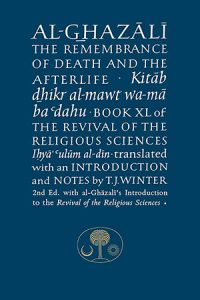Al-Ghazali on the Remembrance of Death and the Afterlife (Ihya Ulumuddin Series No. 40)

Author: Imām Al-Ghazali
Translator: T.J. Winter (Abdal Hakim Murad)
Publisher: Islamic Texts Society
Year of Publication: 2015
Print Length: 378 pages
Genre: Islamic Studies / Quranic Studies; Theology, Ethics and Philosophy; Islamic Law and Jurisprudence; Reflection and Self-Development
Topic: Allah ﷻ, Prophet Muhammad ﷺ, Islam, Qur’an, Death & the Afterlife, Hope
This is the first English translation of a key section of al-Ghazali’s Revival of the Religious Sciences, (Ihya’ Ulum al-Din), widely regarded as the greatest work of Muslim spirituality. Its theme is of universal interest: death, and the life to come. After expounding his Sufi philosophy of death, and showing the importance of the contemplation of human morality to the mystical way of self-purification, al-Ghazali’s takes his readers through the stages of the future life: the vision of the Angels of the Grave, the Resurrection, the Intercession of the Prophets, and finally, the torments of Hell, the delights of Paradise, and—for the elect—the beatific vision of God’s Countenance. In this new edition, the Islamic Texts Society has included a translation of Imam Ghazali’s own Introduction to the Revival of the Religious Sciences which gives the reasons that caused him to write the work, the structure of the whole of the Revival and places each of the chapters in the context of the others.
Table of Contents
Al-Ghazāli’s Introduction to the Revival of the Religious Sciences
Abbreviation
Preface
Introduction
Notes to Introduction
Prologue 1
THE FIRST PART
1. On the Remembrance of Death, and an Encouragement to Remember it Abundantly.
An exposition of the excellence of the remembrance of death, however done. / An exposition of the way to bring about the recollection of death, in the heart
2. On Lengthy Hopes, and the Merit of Brief Hopes, together with the Reason for their Prolongation, and how this may be Cured.
The merit of brief hopes / From the Narratives / An exposition of the cause of lengthy hopes, and how they may be cured / An exposition of people’s diverse ranks in lengthy and brief hopes / An exposition of making haste to works, and a warning about the unworthiness of delay
3. On the Agonies and Violence of Death, and the States Preferable upon its Advent.
An exposition of the states preferable in the dying man / An exposition of the sorrow felt upon meeting the Angel of Death, through accounts uttered on the tongue of the Spiritual State
4. On the death of the Emissary of God (may God bless him and grant him peace), and of the Rightly-guided Caliphs after him.
The death of the Emissary of God (may God bless him and grant him peace) / The death of Abu Bakr al-Siddig (may God be pleased with him) / The death of ‘Umar ibn al-Khattab (may God be pleased with him) / The death of ‘Uthmän (may God be pleased with him) / The death of Ali (may God ennoble his face)
5. On the Sayings of the Caliphs, Princes and Righteous Men when Nearing Death.
An exposition of the sayings of a number of the most righteous men amoung the Companions, the Followers, and the Sufis who came after them
6. On the Sayings of the Gnostics at Funeralsa nd Cemeteries, and the Legal Verdict concerning the Visitation of Graves.
An exposition of the condition of the grave, and of their sayings at the graveside / Some verses found inscribed upon graves / An exposition of their sayings upon the death of a child / An exposition of the visitation of graves, the offering of supplications for the deceased, and related matters
7. On the True Nature of Death, and what the Dead Man Undergoes in the Grave prior to the Blaston the Trump.
An exposition of the true nature of death / An exposition of thegrave’s discourse to the dead, and of their utterances, either on the toungue of common speech, or that of the Spiritual State / An exposition of the Punishment of the Grave, and the questioning of Munkar and Nakir / An exposition of the questioning of Munkar and Nakir, their aspect, and the straitening of the Grave, and the remainder of what needs to be said regarding the Punishment of the Grave
8. On the States of the Dead which have been known through Unveiling [mukashafa] in Dreams.
An exposition of visionary dreams which reveal the states of the dead and the works which have brought advantage in the Afterlife / An exposition of the visionary dreams of the Shaykhs, may God be pleased with them all
THE SECOND PART
1. The Trumpet-Blast
2. The Land and People of the Concourse
3. The Perspiration
4. The Length of the Day of Arising
5. The Day of Arising, and its Calamities and Names The Inquisition The Scales
6. The Adversaries, and the Restoration of Wrongs The Traverse The Intercession
7. The Pool
8. The Inferno, and its Terrors and Torments Heaven, and the Varieties of its Bliss The Number of the Gardens
9. The Wall of Heaven, its Land, Trees and Rivers The Raiment of Heaven’s People, their Furnishings, Beds, Divans and Tents
10. The Food of Heaven’s People
11. The Large-eyed Houris and the Pages
12. An Exposition of a Diverse Group of the Attributes of Heaven’s People for which Accounts are Forthcoming
13. The Beatific Vision, and the Beholding of the Countenance of God (Blessed and Exalted is He!)
Notes
Appendix: Persons Cited in Text
Index to Qur’ānic Quotations
Qur’ānic chapter titles cited
Bibliography
General Index

Imām Abu Hamid al-Ghazali is a 11th century Muslim scholar. He was one of the most prominent and influential philosophers, theologians, jurists, and mystics of Sunni Islam. Al-Ghazālī was born at Ṭūs (near Mashhad in eastern Iran) and was educated there, then in Jorjān, and finally at Nishapur (Neyshābūr), where his teacher was al-Juwaynī, who earned the title of imām al-ḥaramayn (the imam of the two sacred cities of Mecca and Medina). He was active at a time when Sunni theology had just passed through its consolidation and entered a period of intense challenges from Shiite Ismâ’îlite theology and the Arabic tradition of Aristotelian philosophy (falsafa). Al-Ghazâlî understood the importance of falsafa and developed a complex response that rejected and condemned some of its teachings, while it also allowed him to accept and apply others. His great work, Iḥyāʾ ʿulūm al-dīn or Ihya Ulumuddin (“The Revival of the Religious Sciences”), made Sufism (Islamic mysticism) an acceptable part of orthodox Islam.
Source: https://plato.stanford.edu/entries/al-ghazali/
More from Imam al-Ghazali in this library, click here.

Abdal Hakim Murad / T.J. Winter is the Founder and Dean of Cambridge Muslim College. He was educated at Cambridge, Al-Azhar and London universities. He is currently the Shaykh Zayed Lecturer of Islamic Studies in the Faculty of Divinity at Cambridge University and Director of Studies in Theology at Wolfson College. He has published and contributed to numerous academic works on Islam, including as Director of the Sunna Project, and is a leading figure in inter-faith activity, notably as one of the signatories to the Common Word statement. He is well-known as a contributor to BBC Radio 4’s ‘Thought for the Day’.
Source: https://www.cambridgemuslimcollege.ac.uk/ahm/
More from Abdal Hakim Murad / T.J. Winter in this library, click here.
